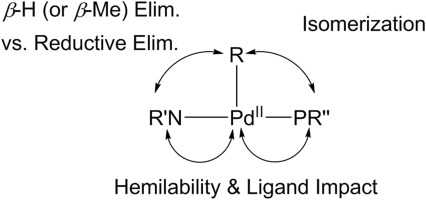Carbon (sp3)-nitrogen bond-forming reductive elimination from phosphine-ligated alkylpalladium (II) amide complexes: A DFT study

DFT methods were employed to investigate C(sp3)-N bond-formation via reductive elimination from alkylpalladium(II) amide complexes. The hemi-lability of an ortho-methoxy substituent is computed to have minimal impact on reductive elimination barriers. In general, for both anilide and phosphine substituents, their steric impact is more substantial than electronic/Hammett factors. β-Hydrogen elimination is competitive with reductive elimination while β-methyl elimination is much less favorable. For phosphine-ligated Pd(II) amide complexes, the solvent impact on reductive elimination free energy barriers is small, and overall the substituent effects on either the phosphine or anilide ligand are subtle.
Read more on publisher's site.